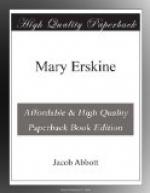She determined, after a great deal of consideration and inquiry, to lay out this money in buying four shares in the Franconia bridge. These shares were originally one hundred dollars each, but the bridge had become so profitable on account of the number of persons that passed it, and the amount of money which was consequently collected for tolls, that the shares would sell for a hundred and ten dollars each. This ten dollars advance over the original price of the shares, is called premium. Upon the four shares which Mary Erskine was going to buy, the premium would be of course forty dollars. This money Mary Erskine concluded to borrow. Mr. Keep said that he would very gladly lend it to her. Her plan was to pay the borrowed money back out of the dividends which she would receive from her bridge shares. The dividend was usually five per centum, or, as they commonly called it, five per cent., that is, five dollars on every share of a hundred dollars every six months.[A] The dividend on the four shares would, of course, be twenty dollars, so that it would take two dividends to pay off the forty dollar debt to Mr. Keep, besides a little interest. When this was done, Mary Erskine would have property in the bridge worth four hundred and forty dollars, without having used any more than four hundred dollars of her farm money, and she would continue to have forty dollars a year from it, as long as she kept it in her possession.
[Footnote A: Per is a Latin word meaning for, and centum another meaning a hundred.]
When the rest of the money for the farm was paid, Mary Erskine resolved on purchasing a certain small, but very pleasant house with it. This house was in the village, and she found on inquiry, that it could be let to a family for fifty dollars a year. It is true that a part of this fifty dollars would have to be expended every year in making repairs upon the house, so as to keep it in good order; such as painting it from time to time, and renewing the roof when the shingles began to decay, and other similar things. But, then, Mary Erskine found, on making a careful examination, that after expending as much of the money which she should receive for the rent of her house, as should be necessary for the repairs, she should still have rather more than she would receive from the money to be invested, if it was put out at interest by lending it to some person who wanted to borrow it. So she decided to buy the house in preference to adopting any other plan.
It happened that the house which Mary Erskine thus determined to buy, was the very one that Mr. Gordon lived in. The owner of the house wished to sell it, and offered it first to Mr. Gordon; but he said that he was not able to buy it. He had been doing very well in his business, but his expenses were so great, he said, that he had not any ready money at command. He was very sorry, he added, that the owner wished to sell the house, for whoever should buy it, would want to come and live in it, he supposed, and he should be obliged to move away. The owner said that he was sorry, but that he could not help it.




